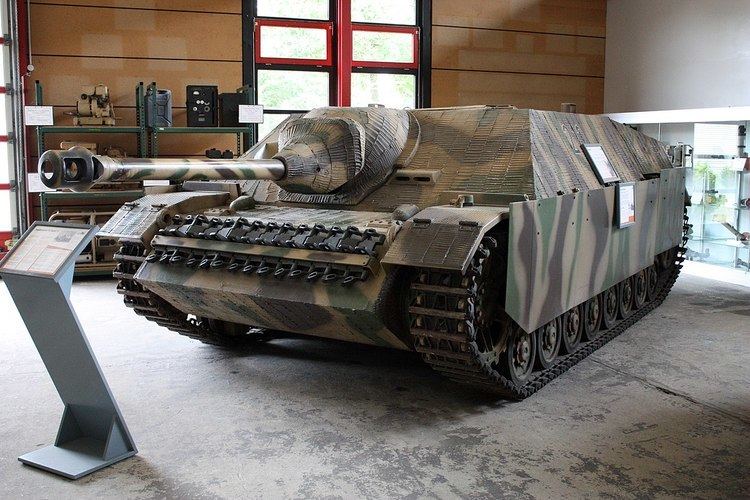 | ||
Jagdpanzer (JgPz), German for "hunting tank", is a name given to German self-propelled anti-tank guns.
Contents
It typically refers to anti-tank variants of existing tank chassis with a well-armoured casemate fixed superstructure, mounting an anti-tank gun with limited traverse in the front, and usually classed by the western Allies of World War II as a tank destroyer.
History
The Jagdpanzer designs followed on from the more lightly armoured Panzerjäger ("tank hunter") designs, which took an anti-tank gun and mounted it on top of a tank chassis with supplementary armour fitted around the gun crew, but due to its generally open rear and top, almost never providing the crew with full protection from the elements. Also, a lot of experience was gained from the Sturmgeschütz series of assault guns for infantry support, which already used heavily armoured casemates, completely enclosing the vehicle's crew—although they were associated with the artillery, they were very often used in the anti-tank role.
Tactical use
On the battlefield, the Germans sometimes had to retreat, or try to feign one. Their line of retreat would then preferably pass the location of their anti-tank units, who would use their superior firepower to stop the enemy, perhaps even make possible a counter-attack. Due to the lack of a turret and the armour being concentrated at the front, the ideal combat situation for Jagdpanzer units was in the planned ambush, and the skill of the commander of such units lay in correctly choosing and preparing such places long before needed.
Types
Notable tank destroyers of World War II in the Jagdpanzer classification include:
Post-war
After the war, the name Jagdpanzer was kept in use in the Bundeswehr for a number of armoured vehicles used for anti-tank duties. This included the casemate-style Kanonenjagdpanzer carrying a 90 mm gun and the Raketenjagdpanzers. The first Raketenjagdpanzer was the Raketenjagdpanzer 1 built on the chassis of the SPz Lang HS.30 and armed with SS.11 missiles. The Raketenjagdpanzer 2 was built on the same chassis as the Kanonenjagdpanzer, but was equipped with two SS.11 launch-rails instead of carrying a gun.
Later, the Raketenjagdpanzer 2 and the Kanonenjagdpanzer were upgraded to Jaguar 1 and Jaguar 2 tank destroyers, armed with HOT or TOW missiles.
